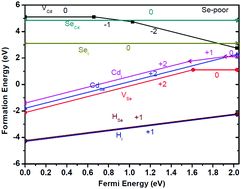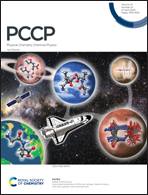Hybrid density functional studies of native defects and H impurities in wurtzite CdSe
Abstract
In this study, the formation energies and electronic properties of six native defects as well as H impurities in wurtzite (wz) CdSe are systematically investigated using hybrid density functional calculations. It is shown that native defects, including antisite CdSe and interstitial Cdi, may be sources of the unintentional n-type conductivity in CdSe under Se-poor conditions; meanwhile, the vacancy defect VSe is not a good donor. However, when the common H impurity is considered, it is suggested that both the substitutional impurity HSe and the interstitial impurity Hi are the dominant and effective origins of the unintentional n-type conductivity in Se-poor conditions. However, unintentional p-type conductivity in CdSe is challenging to form regardless of the growth conditions. Moreover, hybrid functional calculations of the electronic structures show that the six native point defects and the extrinsic impurities Hi and HSe will cause more or fewer changes in the band gap. Among all considered defects and impurities, it is found that only the interstitial defect Cdi introduces impurity levels into the band gap. In particular, the present hybrid functional calculations theoretically affirm that the vacancy defect VCd in CdSe can induce a 2 μB magnetic moment; however, other native defects will not introduce any magnetic moment.



 Please wait while we load your content...
Please wait while we load your content...